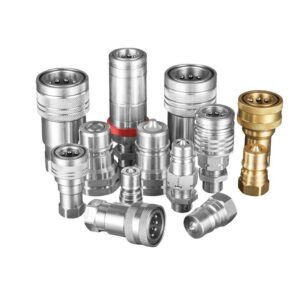Quick connect fittings are connectors used to connect fluid lines to equipment. They can be easily used without tools, simply by pushing them together. Quick-connect fittings are used in hydraulic and pneumatic systems, especially when time is tight and it is necessary to quick way to connect lines without losing fluid pressure. This blog post will introduce what they can do, types, and how to choose them.

ما هي اتصالات سريعة?
The Quick connect fittings, also known as the quick disconnects and the quick coupler, is a hydraulic fitting used for quickly connecting fluid transfer lines. The quick connects can replace threaded and flanged fittings that require tool to install and remove through manual operation. Quick connection hydraulic fittings are widely used in various systems, including plumbing, heating, electrical, and fire suppression systems. They offer a significant time saving benefit over traditional hydraulic fittings and require little skill to operate.
How do Quick Connects work?
The quick connection inserting by inserting the tube into a connector, which will fastening teeth onto the surface of the tube. When an opposing force is applied to the hydraulic fittings, these teeth will be forced deeper into the tube, thereby preventing separating.
Different kinds of quick-connect fittings
Quick connect couplings come in different styles. Some of the ones that are used most often are:
To connect, push
Push-to-connect fittings work the same as ball-and-sleeve connections: you push one end into the other. To unhook, a collar needs to be pulled back.
Sleeve and ball
This type of connection has a sleeve that can be pulled out and used to connect the two halves of the coupler. The end with the ball fits into the end with the sleeve.
FloLok Quick
FloLok Quick Connects is a type of ball and sleeve fitting that SSP sells.
Cam-lock
For this type, the receiver is held in place by tabs that can be folded. This connection is used for things like sewage pumping and fire hoses, which both use hoses.
Luer lock
Luer locks fit together by twisting and are usually made only to be used once. Most of the time, they are used in the medical field.
Twist or bayonet
With a 1/8 to 1/4 turn, you can connect and disconnect fittings that twist or have a bayonet.
Choose the right quick connects
When choosing quick connects suitable for any industrial application, several key factors must be considered to ensure optimal performance and safety. Each aspect plays a crucial role in choose whether the fast-release coupling is suitable for a specific application.
Materials for quick connects is of vital importance to their performance and lifespan. Commonly used materials include stainless steel, brass, and plastic.
Stainless steel is strength and corrosion resistance, making it ideal for harsh environments.
Brass is widely chosen for its corrosion resistance and compatibility with various fluids, while plastic is preferred for its light weight, economy, and suitability for applications with low requirements.
The choice mainly depends on the type of fluid being transported, environmental conditions, and the required durability.
The size of the quick connects must match the size of the hose. An improperly sized coupler may cause leakage or a complete failure of the connection.
Compatibility with the existing system is equally crucial, which includes not only the physical size but also the design standards and operating parameters of the system. To select a quick connects that can be seamlessly integrated, one must fully understand the requirements of the system.
The quick connects must be able to withstand the operating pressure of the system. Each connector has a maximum operating pressure rating. Choosing a connector that meets or exceeds the system requirements is crucial; otherwise, it could lead to dangerous situations, including the rupture of the connector or the connection hose.
The working environment plays a crucial role in the selection process. For applications exposed to extreme temperatures, corrosive substances, or ultraviolet radiation, it is necessary to choose couplings that can maintain their performance and not deteriorate under these conditions. Additionally, factors such as vibration, pulsation, and the presence of abrasive materials in the fluid also influence the selection of couplings.
The selection of quick connects is not fixed. Different industries have unique requirements and environments, so there are specific requirements for quick-release couplings. Understanding these requirements is crucial for ensuring that the selected quick connects is applicable and for improving operational efficiency and safety.